I recently came across a post with a photo of some vintage and very rare conga drums I had sold to a local guy in California, only to discover later that they had found a new home in a museum.
Quite frequently I see my drums, or what used to be my drums on posts and photos. And of course, they came from someone or several different people before me.
It’s fascinating to think about how many hands those instruments have passed through. And also the stories they could tell! The parties and rumbas they were at. People often say that drummers can fall out of love with their instruments easily, and I can certainly relate to that sentiment.
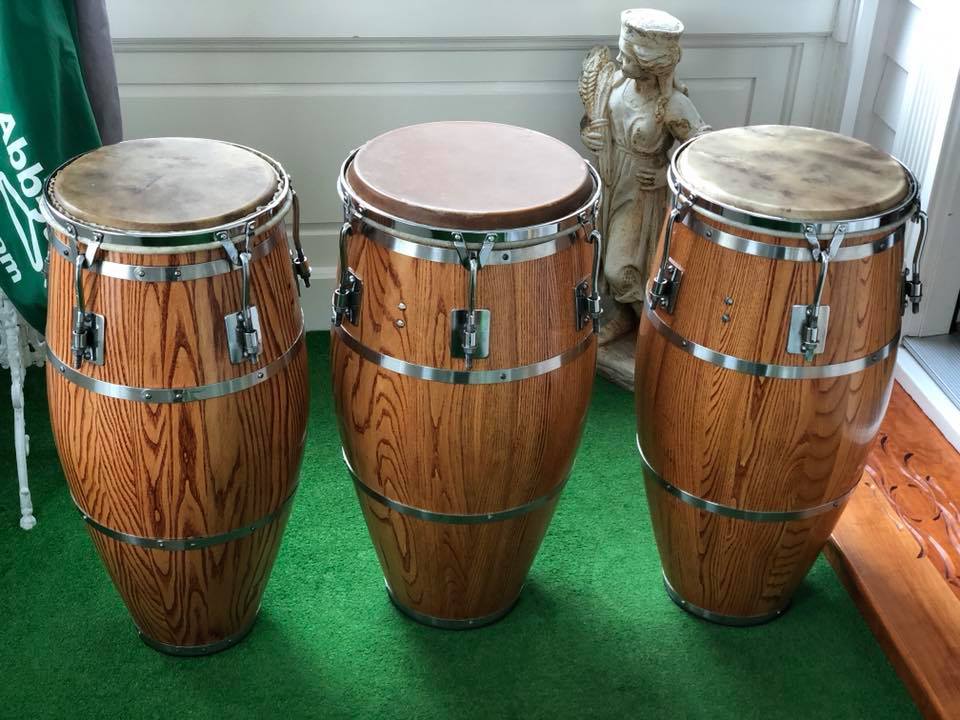
Skin On Skin Ash Wood Congas. This is not my original set, I got these some years later to replace the ones I sold. Angel Roldan in NYC restored then for me and did mild stain process to achieve this unique coloration.
These drums were made in NY by the late great Jay Berek. One sure way to know they are his originals is to look inside where he writes in Hebrew language!
Even so, I still hold on to one of my two original Gon Bops congas from 1975, (I pawned the second one to buy a plane ticket to Key West from Boston in1977), and all my black LP fiberglass drums from 45 years ago.
My father actually bought me the drums which I will forever be grateful for. They came from the conga player from the Miami Sound Machine. These are in the photo directly below with Manito Percussion pre mounted steer skins I put on about eight years ago which totally transformed the sound!
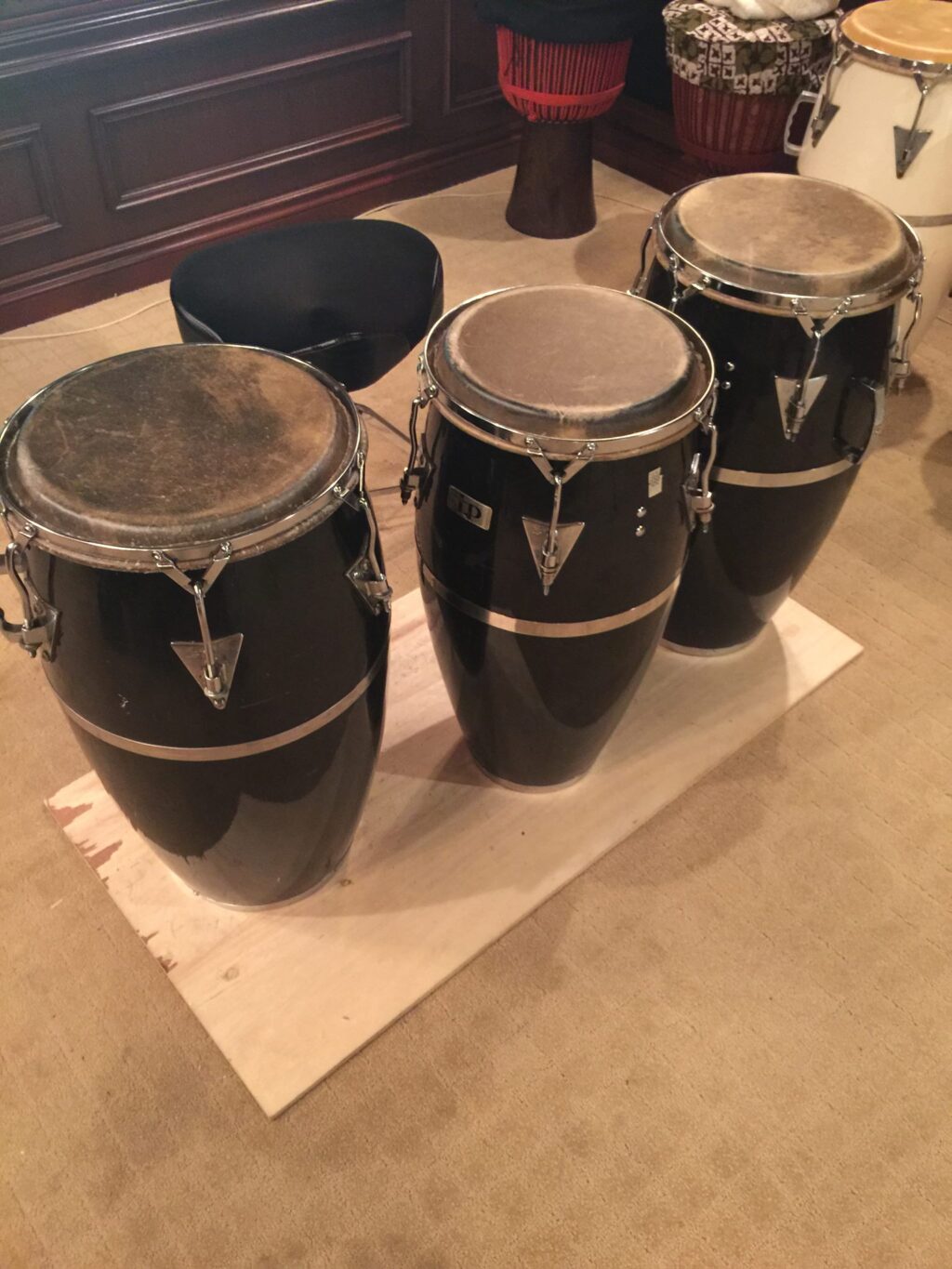
Much of my collection of congas and djembe drums, however, has come and gone, seemingly lost to time. But I am happy to have had them, played them all, recorded with them, partied with them, performed with some and hopefully put them in good hands!
Reflecting on my journey, I find that I carry few regrets, but I do wish I hadn’t sold some of my higher-end, boutique artisan drums — like those from Skin On Skin, Matthew Smith’s Ritmos, Sonoc Cuban drums, and the Volcano exotic wood drums from the Big Island of Hawaii. These drums you cannot simply walk into a store and buy. Volcano Percussion congas were made by the late Tom Alexander on the Big Island of Hawaii using exotic Hawaiian hardwoods found only in the islands there. Volcano Percussion Made In Hawaii.
You cannot export this wood by itself off of the island of Hawaii, it can only be exported as a finished product making these drums very rare indeed. And you don’t see them come up for sale very often.
Jay Berek from Skin On Skin passed away, Junior Tirado from Juniors drums passed on and I am told Matthew Smith is now making furniture again. Isla drums stopped making drums and moved out of the country to Belize and the list goes on and on. The drums below in the photo are Matthew Smith oak wood drums I once had.
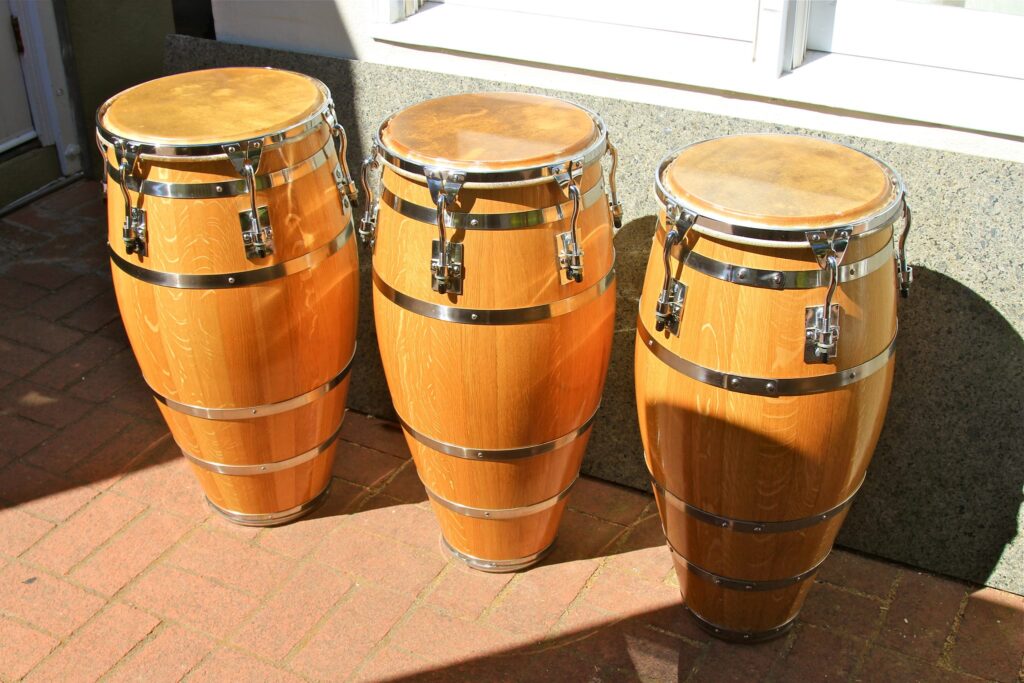
Matthew Smith Oak conga drums. He had two different styles of top rims. Some of his drums were off the chart great!
Some of my drums like my original Skin On Skin congas took me years to aquire. In 1985 I got my first two after saving up for a year. There were no other boutique artisan drum makers at the time, other than Fat Congas, at least none that I knew of.
I had first seen Fat Congas when I was working as a street salesman for a guy named Steve Mah who had a set. They were totally mesmerizing and very expensive at the time. I felt so fortunate just to be able to play them with him and our mutual friend Jerry Shilgi who had got me the job selling items on the street. It would be over 25 years later when I would get my first set!
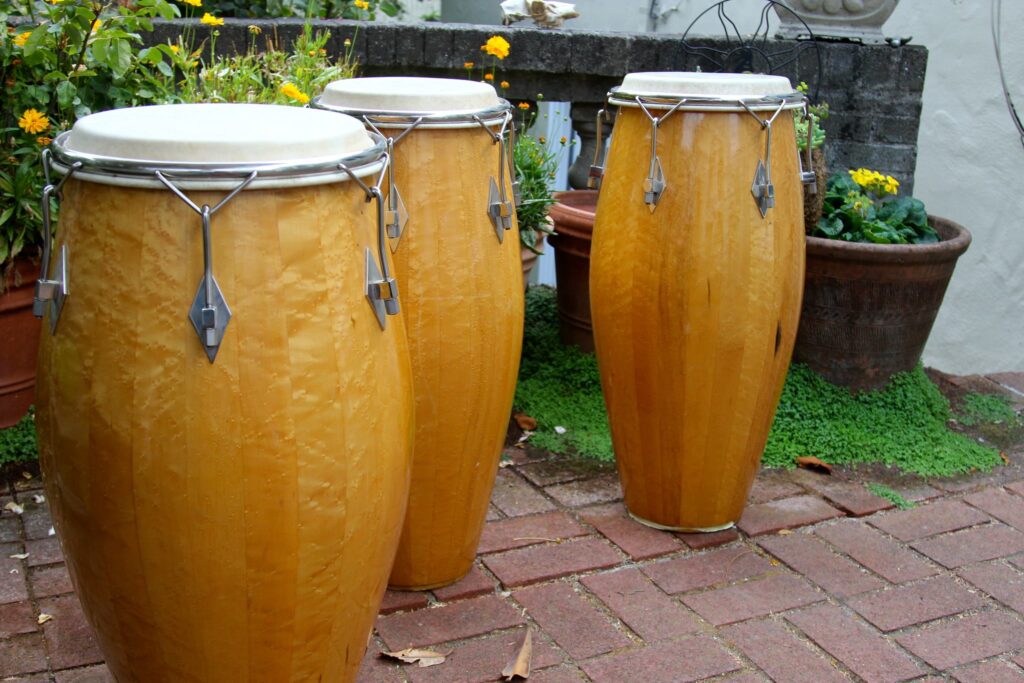
Fat Congas were made by Jim Long in Newbury Park, California. Jim Long is a drummer, a craftsman, and a mystic. What better combination is there?
This set was made out of very rare Birds Eye maple wood. His stainless steel comfort style rimes were way ahead of their time!
He stopped making the congas and was making wooden cajon drums for a while.
But the Skin on Skin were the ones to get at the time. You had to know someone to get Jay’s number, then you had to talk to him on the phone, which was really fun! He was a little grumpy or hard to talk to at first. He definitely was his own man and you don’t tell a guy like him what to do really. A year later I got my third conga drum from him.
They were about $500 each with shipping back then, more or less. Now they are easily $1500 each or even more, sometimes used. They traveled around the world with me as did two of the solid shell one piece conga drums I got from Conrad Kubiak of the company Spirit In The Wood, who also passed a way a few years ago. The drums from Conrad even lived with me in Thailand for a while and even appeared on Thai Television when I performed live with a local jazz group.
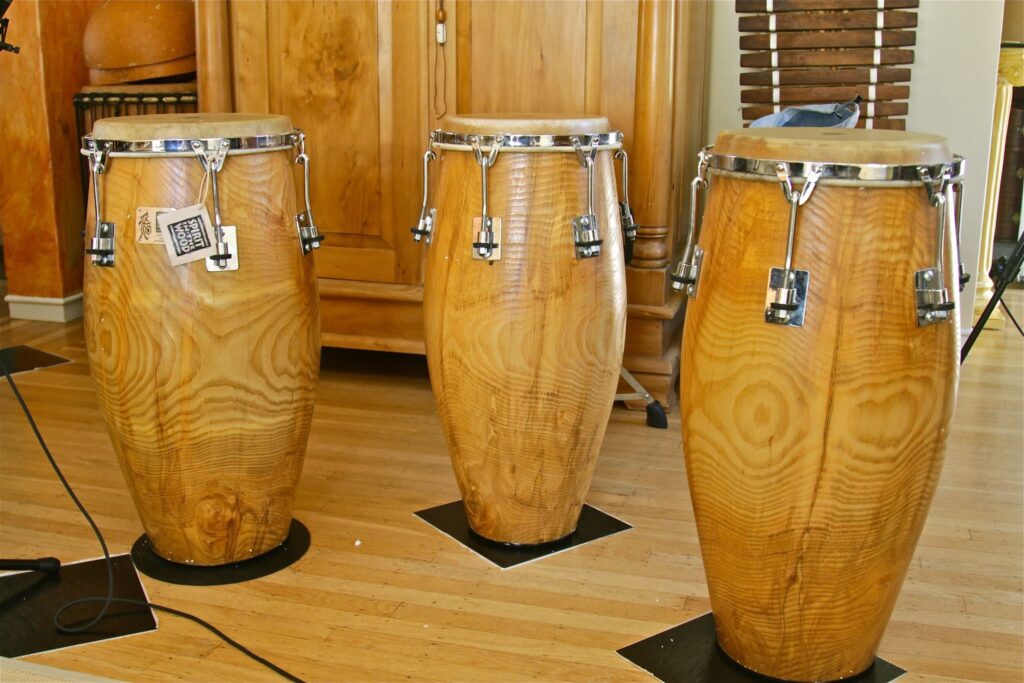
Spirit In The Wood Conga drums by the late great Conrad Kubiak. These are ash wood drums made from logs that are hollowed out on a lathe. Most drums are made from staves, pieces of wood cut out or bent into shape with steam.
These were made in Pennsylvania not that far from where Matthew Smith Ritmos were being made. Odd that two of the very few boutique drum makers were in the same state. Koma Drums djembe and Lucid Drums djembe are both in Ohio, also a fun fact.
Many of my drums were acquired in trades with other vintage conga drum collectors. Often if I wanted something bad enough I would trade three drums of one type to get two of another type, because I needed one of those two I acquired to complete a set. Back in the day, If you wanted certain drums bad enough, if it is a habit and you are jonesing, you sometimes paid top dollar or too much. But it didn’t matter, because you got the drum. It must be like this for any collector of vintage anything.
All the drums in the photos are drums that I have owned for various periods of time. In the videos are drums I have owned but also congas I have borrowed, some from friends and even some I still own but I wanted this particular article to feature all past loves.
The reasons for me selling my personal conga drums and djembes were often pragmatic, needing cash to travel or lacking space to store them. I have always said that no matter how much money someone pays me for a vintage conga drum, I am going to spend that money and the money will be gone. But the drum is not replaceable. If it’s a trade its different because you have something to keep that is tangible.
Many conga drum hunters check Craigslist daily all across the country, watch Reverb and other used musical equipment sites and follow eBay for special finds. I found my Fat maple congas in Berkeley, California that way. And there is of course a small network of vintage collectors, all of whom know each other or know of each other. Some buyers of vintage congas who are new to the scene buy their way in. This means they pay a ridiculous amount for a drum so they can join the club. I look at it like this, it’s their money and they can do what they want. However, it drives, the market value up, at least temporarily, which is never a good thing. The last I heard from Jay Berek, the maker of Skin On Skin before he passed away, was that he wasn’t happy that the price of his used drums had gone up so high.

Oh, I miss this beautiful beast. I wish it was here with me now! This is a Valje conga drum that I had restored. It took one year, It was expensive but worth every penny.
But alas, I sold my entire set. It’s interesting because back in the day, when it was all Gon Bops, LP fiberglass drums and Valje, I was not a fan. I liked the heavy duty Gon Bops congas in Oak.
But I guess my tastes or my ear changed because 40 years later I love the sound!
Even if you find a super great deal on a vintage or classic drum or set of drums, once you are hooked into collecting and owning drums, it becomes like a bad drug habit. You can’t stop! And you might make some money reselling some drums, but then there might be something that you just have to have, and it can be costly.
And there can be drums that look great, they are from a famous name company or artisan, you buy then online and receive them, and they don’t sound good. You change the skins maybe even a couple of times, and no matter what you do , you can not get the drums to sound good! Everyone who has been playing conga drums or djembe drums for a long period of time has a story like this and I have a few as well.
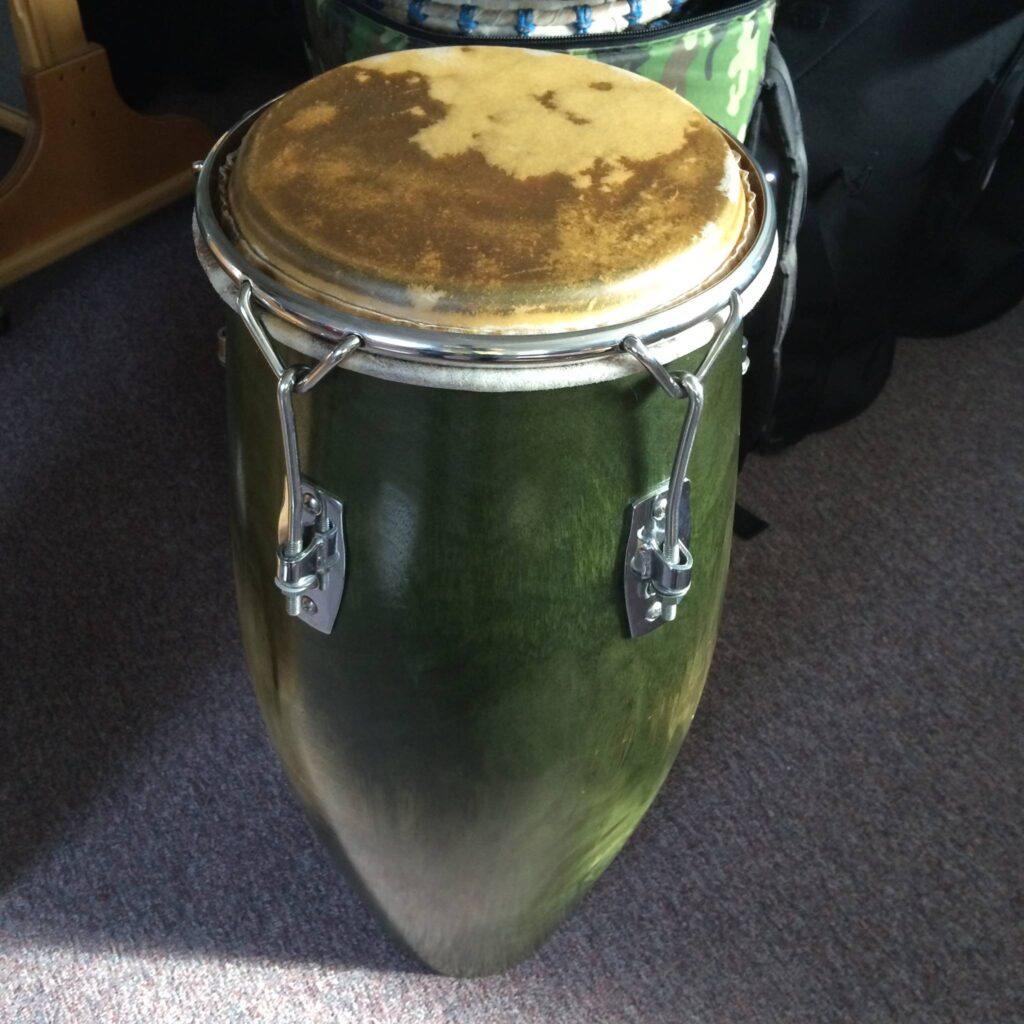
This is a requinto drum, a conga drum used specifically for soloing in Afro-Cuban folkloric rumba music. This is the natural green color of the wood. It is guayacan wood. It is also a solid shell one piece drum from Cuba.
I got the drum from my good friend and master drummer Chief Yagbe Onilu a while back. Manito did all the finish work, fixing some splits here and there and making the custom rim and lugs for the drum.
Now that Yagbe has also passed on, I really regret selling this drum!
In the past I have tried leaving my drums with friends, but whenever I entrusted my drums to friends, getting them back was a challenge, as attachments often formed. it can be like leaving your pet with someone and now they both want to stay together! I recall one instance when a close friend gave a set of my drums to a master drummer who simply needed some drums and didn’t have any, a situation that, while understandable, left me furious.
Luckily another friend who had notified me about the drums being up for sale also helped me purchase them back.
The Valjes in the video below are part of a set of five I used to have. I collected then over the years. Each year I would send one drum to Ralph Flores, Tom Flores’ son to restore. So it took five years! Tom Flores was the original maker of Valje.
You can still find many great Valjes out there in the used marketplace. They are easy to restore as there are no metal bands that often cause problems in restoration. If you put a high quality skin on them they sound great with very full tone.
At one point, my collection was vast, but eventualy I questioned why I was collecting so many drums. It became impractical to play them all, to store them when I traveled and to send them back and forth, which I was doing for a while. Now when I’m in the US I live in a trailer where storage space is limited.
I still need to part with a few, but it’s tough to let them go. Whenever I try to convince myself to sell a particular drum, I can’t help but find reasons to keep it — and I know some readers may not even be familiar with some of these vintage gems. They are so hard to come by.
So why do I regret selling or trading all of these beauties? No matter how much money I got for them, or will get for a drum the money gets spent and then there’s nothing to show for it. Even if it is a super high price. And the drums simply can not be replaced. As you have probably noticed reading this article, most of the drum makers are no longer with us, or have stopped making drums. It’s very demanding on the body and a tough business to be in. So folks move on sometimes.

I had a set of five Volcano congas that I eventually sold by breaking up the set, something I hate to do. These were made out of very exotic Hawaii sourced Monkey Pod and Mango. As you can see they are amazing looking!
My friend Jesse was an endorser for them and had their bata, congas and bongos as well, which we used in live performances and in our recording “Rise Up” by our group Barabajaba in Hawaii. I have seen cracks in a lot of the later Volcano drums for some reason.
The skins are from a source most of the independent companies all used named Bill Confer. When he retired, everyone had to find new sources. Some drum makers still have a stash of what many people believe to be the best skins.
While I wouldn’t call it a collection, I’ve certainly gathered these instruments since the early ’70s. During my mother’s lifetime, I was able to store them at her house, often finding drums stuffed in odd corners. I even stumbled upon a calfskin djembe drum years later from Drumskull Drums of Santa Cruz California tucked away in a closet, still perfectly in tune. Another drum I thought I had lost was actually one I had sold to a friend and forgotten about!
I often carry drums throughout the house, from one room to the next, inside to outside. They almost never stay in one place. I bought some Moperc drums from Canada, right before the ownership changed hands. Really beautiful, great sounding drums. Built to last a lifetime and withstand a beating. But they were much taller then I realized and way too heavy for me to carry around so I sold them to a good friend who is actually quite tall, and they fit him perfectly!
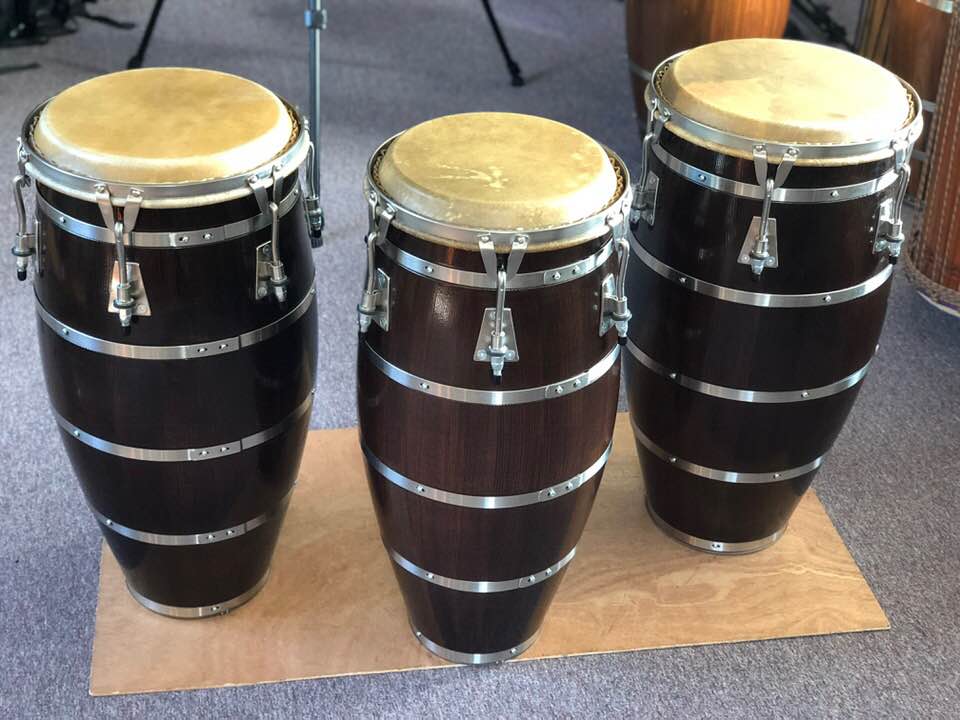
Moperc from Canada are great sounding drums that are built incredibly well. They have wonderful tone and projection as well. Get skins too!
Mine got held up at customs for a while but finally came through. The staves are not steam bent like some of the other boutique artisan drums. They are cut to shape out of individual pieces of wood.
I have heard several great Afro Cuban rumba players play these in videos and they sound as good as anything.
When I was a very young man in my teens I was walking through the music store district I noticed a spectacular drum in the Manny’s Music store window. Manny’s Music was a leading music retailer and New York institution for over 60 years epitomizing both the glory and the grind of the music biz.
Anyway, the drum stopped me in my tracks. I was mesmerized by it. It was a Junior Tirado drum. I fell in love. Many years later I was able to realize my childhood dream and piece a set together. One I got without a skin and one with a stock LP skin. I put two high quality steer skins on them despite being warned that they were too thin by the Conga Doctor Tony S. I did not realize the the Honduran Mahogany wood was so resonant. They did not sound good so I put bleached cow skin on them and that made them sound fantastic. I was able to get a third drum as well.
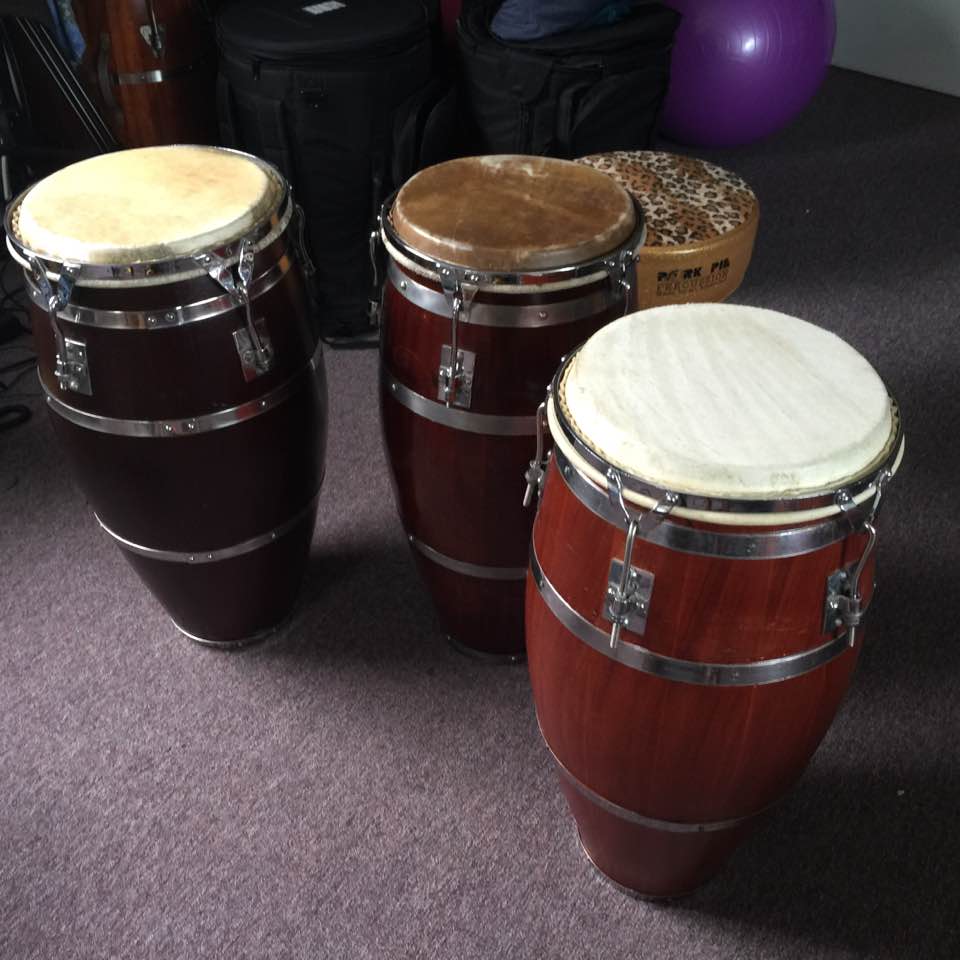
These Junior Tirado drums had been through many hands of many different people I know both personally and online .
The vintage drum collectors world is very small and the chances are that whatever drum you had, someone in this community knows about it, had it or will have it someday! Especially if it is a Junior Tirado.
They were built in the ’70s when the glue was not advanced and as strong as it is today. They are made from Honduran mahogany. That was his wood of choice .
Junior’s staves, the pieces of wood that get glued together, were extra wide. He also joined the staves if one piece wasn’t long enough. He would put two pieces together to make one piece. I have not seen any other drum builder do this.
In the past, all of the Juniors I had were heavily repaired drums, and they had not been repaired well. Some I had restored by Angel Roldan, and others really needed and deserved a full restoration which I was not able to do at the time. So they moved on in a trade deal.
The moral of the story might be this. Cherish the things you love and recognize their value, whether in friendship or passion. Letting go can be tough, but sometimes it’s the memories and connections that matter most.
Here is a video of me playing 7 different set of vintage high end drums I used to have. Most are gone now, but their memory lives on!
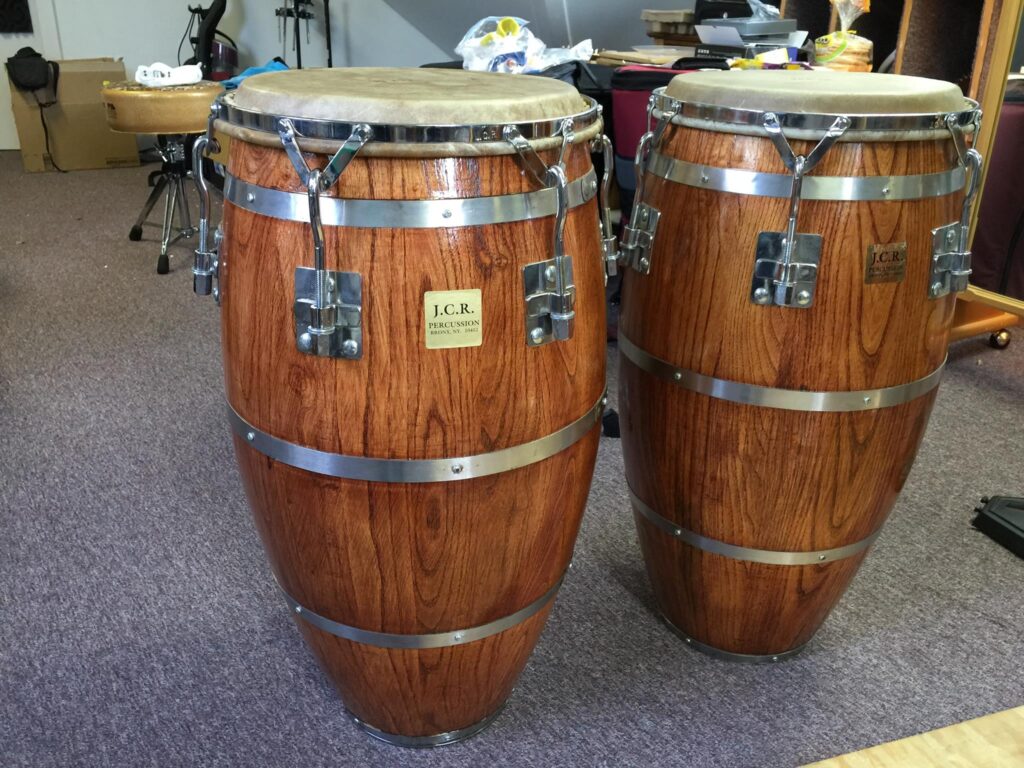
JCR congas, metal work by the legendary Cali Rivera in the Bronx, NY. No one knows where most of his conga shells came from. They could be sourced from anywhere. Peter Musser even made some for him.
Very hard to find and rare. It took me forever to get these drums. Not sure who has them now though. Big, heavy, and great sound, too. They are in one of the demo videos I posted above.
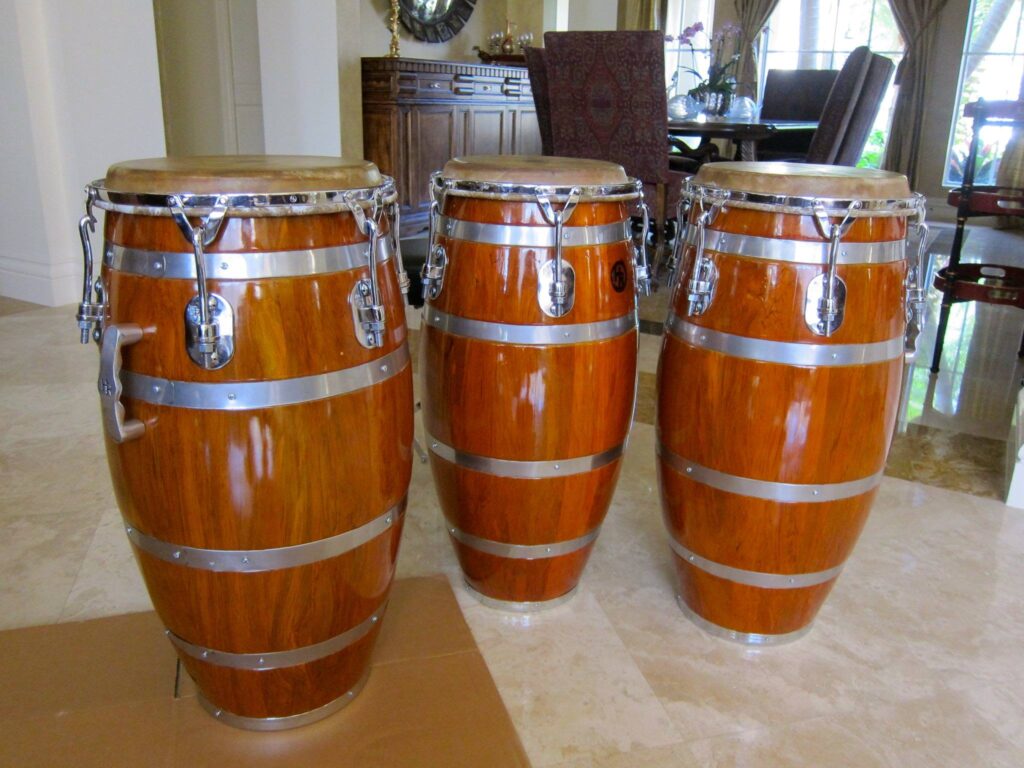
I got these from a guy named Jason T. on the Conga Drum Forum, (Conga Place), that used to be the online place to go to find congas and percussion before Facebook groups and pages started happening.
They are called “El Piernas HR” and they are from a small family and maker in Cali, Colombia. He is known for his bongos, which are very heavy by the way.
This particular set was said to be very rare as they were made in Cedar wood. Also know as “Cedro”.
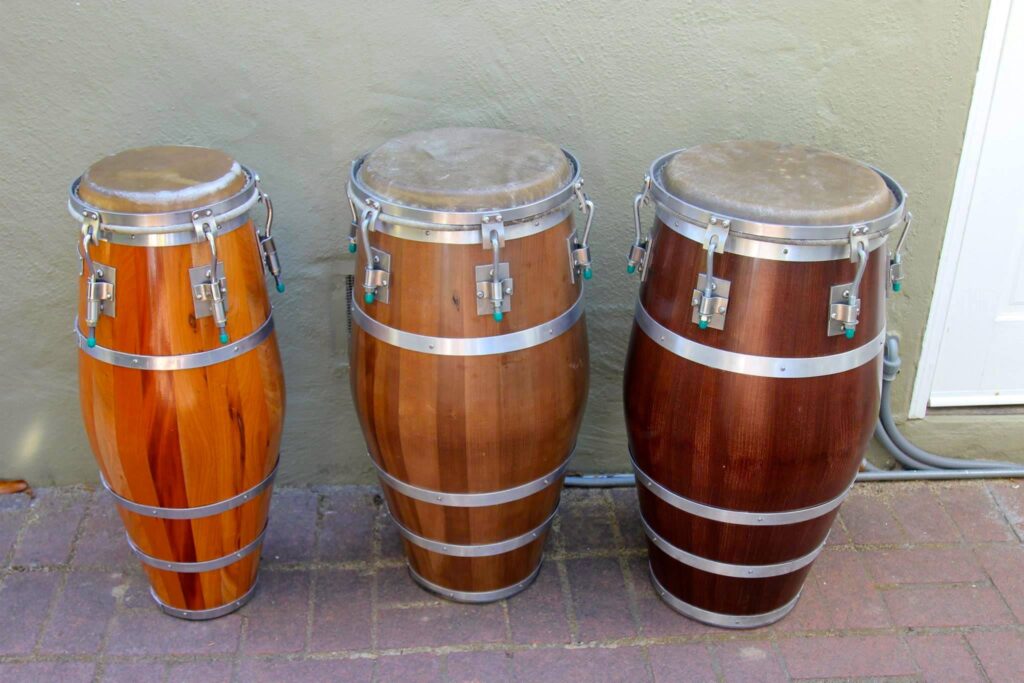
These are Isla congas. I got two then added the requinto. They were made by Mario Punchard. He is now in Belize. Early Isla had some issues so be careful and inspect the drum carefully if you are buying any Isla drums used.
These were great rumba drums but with not as much attention to detail as Manito, PM Percussion, or Vega Drums, which all have much better attention to detail.
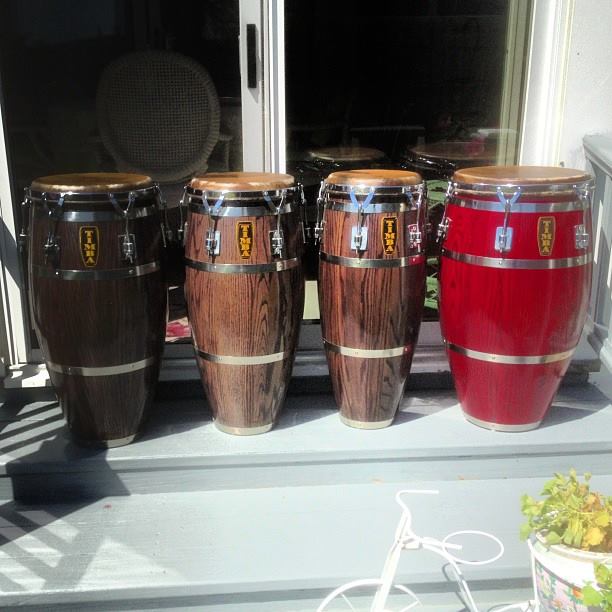
Timbas is the short lived company that basically took over Gon Bops prior to Akbar and then Sabian re using the Gon Bops name, and used their tooling and materials. I don’t think there were major changes to their new drums.
Although I have not owned any of the new Gon Bops since Akbar was involved, I did a sound demo of them in the first video in this article and his California series I thought sounded as good as any other drums!
If you buy any of the new Gon Bops California series used, please make sure they have his signature inside!
Below is a sound check / video of me playing my full set of Volcano Percussion Monkey Pod / Mango wood conga drums about 10 years ago in Maine. How time flies when you are having fun!
This is in my old studio before my mom sold the house. I am using Chinese ribbon microphones,
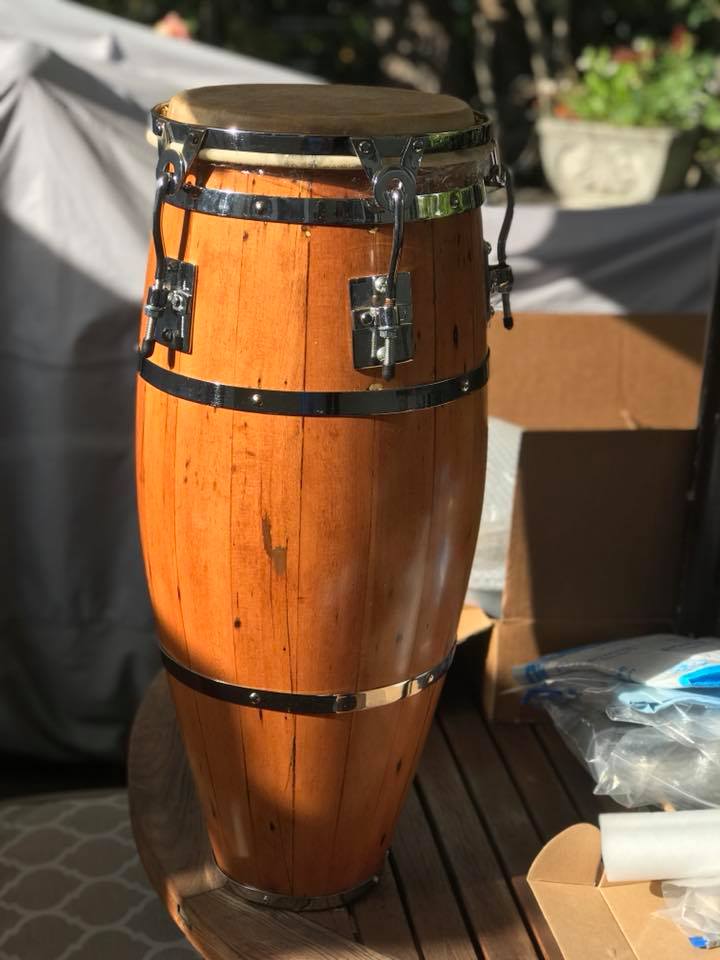
Here is an interesting Junior Tirado 9″ requinto. It has a very small head. A real screamer. It has passed through many hands.
The legendary percussionist Johnny Conga had it for a while way back when. He had welded the washers onto the V-hooks on the rim. It sure is an unusual look.
He mentioned, ” I bought that requinto in a Willis Ave. pawn shop in the Bronx, back in 1972 for 50 bucks. I had it over 40 years… now it has new life… great to see!”
This drum is no longer with me, not sure where it is now. Angel Roldan in New York restored it for me in.
The video below has two Junior Tirado conga drums. This one and a tumba that came to me with a synthetic head.
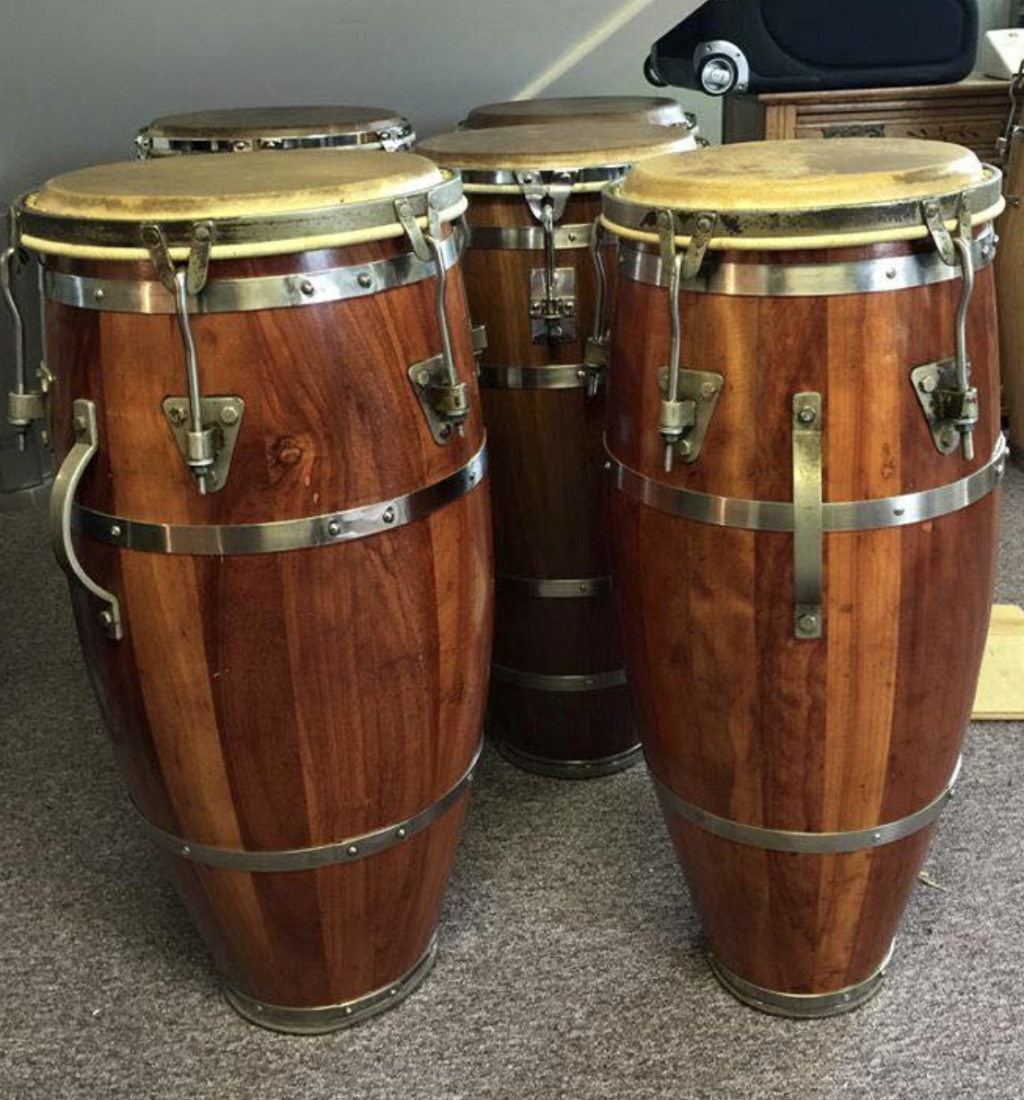
The major Cuban conga drum maker in the past was Sonoc. Until the factory burned down. Then they completely stopped production. These drums sound exactly like the drums on the Los Munequitos albums!
There is not much consistency in the Sonoc drums or design other than the side plates. I have some very old ones and have had the newest ones as well. These two were my favorite. They were made from a much heavier wood then all the others.
I sold them to a guy in Canada and I believe that one or both of them developed some kind of cracks although when they were with me they never had any. The thinner lighter Sonocs don’t sound anywhere near as good as the heavier weight ones in my opinion.
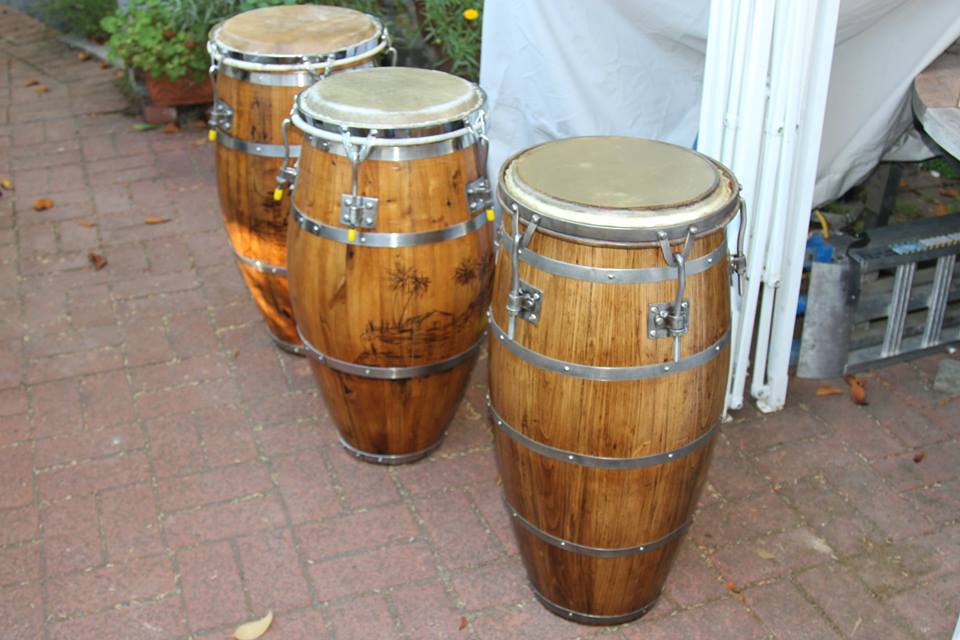
These are Timbas Ismael from Puerto Rico. Not sure of the exact years, late ’60s or early ’70s for the two on the left. I got those two from Dario in Miami. Another amazing sounding set of very rare drums with extra wide bellies.
Anyone who has been in the vintage conga drum scene or forums for any amount of time knows Dario as he has had the absolute best vintage drums come through his hands. He was a personal friend to the late great Mongo Santamaria and many other great artists as well and he still has some amazing drums in his collection.
Whenever I have a question, (which is often) as to what kind of drum some mystery drum is, he almost always has the answer!
Tony Pope Stearn, the former “Conga Doctor” restored the one on the far right.
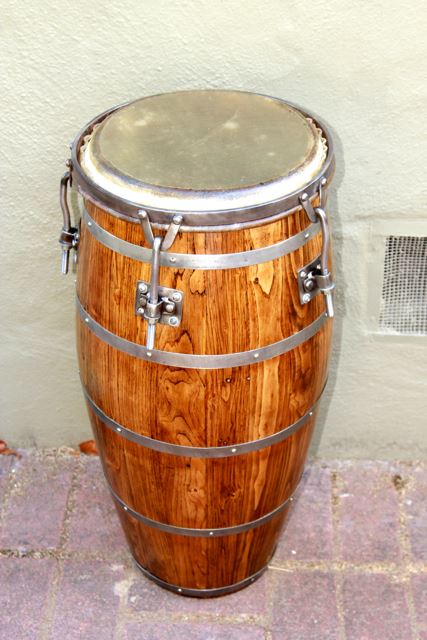
This is another Timbas Ismael made in Puerto Rico in the 1970’s. Thesis not in the demo video above.
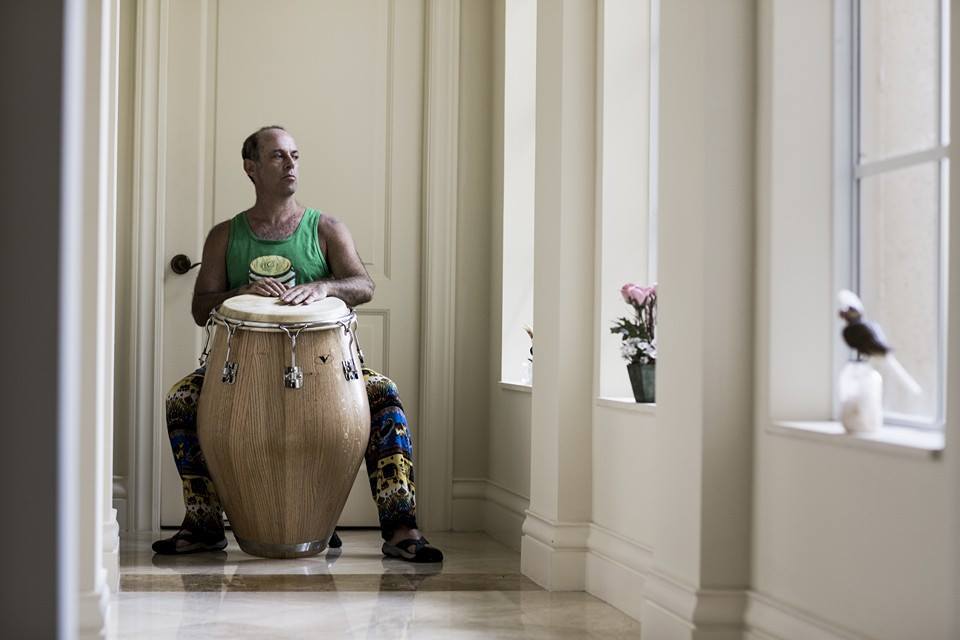
This is by far the largest tumba I have ever had. No, it’s not a Candombe drum from Uruguay. It is in fact, a mega tumba from Orlando Florida drum maker Lou Vega. It’s 14.5″. Fantastic sound, it’s in one or two of the demos above in this article. He is another one man operation with an amazing attention to detail. His drums are inspired by the work of the late Tom Flores of Valje.
